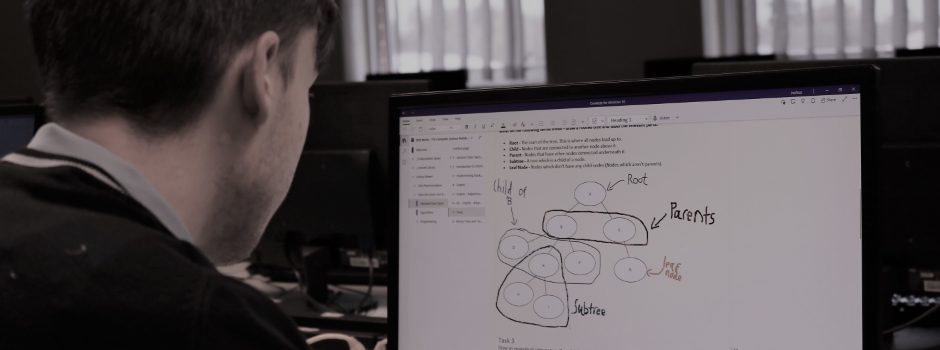



















































"You completely changed her life around and for that we are eternally grateful."
Business Studies Dept - Curriculum on a Page
Showing the curriculum by subject
Business (Applied)
Curriculum Details - 2024/2025 (Current)
| Year | Term 1 | Term 2 | Term 3 | Term 4 | Term 5 | Term 6 |
| 12 | Unit 1 Ex - Financial planning and analysis: Business planning, legal structures, financing the enterprise, costs and revenue, making a profit, break-even and cash flow. Unit 2 CW - Dynamic nature of Business: Understand business organisations. P1/P2/P3/M1/M2. Careers - job roles and structures. | Unit 1 Ex - Financial planning and analysis: budgets, using break-even, interpreting financial data, interpreting ratios, market information and stakeholder perspectives. Unit 2 CW - investigate current bus advantages. P4/P5/P6/M3/M4/M5/D1/D2. Careers - viewing recruitment docs and processes. | Unit 2 Coursework - Dynamic nature of Business: consider business dynamics. P7, P8, M6, M7, D3, D4. Careers - Considering the roles of managers. | Unit 2 CW - Dynamic nature of Business: assess business potential. P9, P10, M8, M9, D5, D6. Careers - labour market information. Unit 3 - Entrepreneurial Opportunities: understanding enterprising behaviour. Investigate CVP's for personal enterprise. Careers - creating their own business ideas. | Unit 3 - Entrepreneurial Opportunities: Consider marketing and operations activities for personal enterprise. Review the risks and uncertainties of personal enterprise. Careers - creating their own business ideas. | Unit 5 - Developing a Business Proposal: Investigate potential business ideas. P1, P2, M1, M2, D1. Careers - creating their own business ideas. |
| 13 | Unit 4 - Managing and Leading People: investigate the roles of managers and leaders. Investigate the factors affecting the performance of employees within organisation. Unit 5 - Developing a Business Proposal: Develop a business proposal. P3, P4, P5, P6, M3, M4, M5, D2, D3. | Unit 4 - Managing and Leading People: assess the ability of managers to lead and empower employees. Assess the use of leadership and empowerment to implement organisation change. Unit 5 - Developing a Business Proposal: Present a business proposal to funding providers. P7, P8, M6, M7, D4. D6. | Unit 5 - Developing a Business Proposal: Review a business proposal. P9, P10, M8, M9, D6. Unit 7 - Managing an event: Investigate events delivered by small businesses. P1, P2, M1, M2, D1. Careers - potential career progression. | Unit 7 - Managing an event: Plan an event. P3, P4, P5, P6, M3, M4, M5, D2, D3. Careers - identifying the roles and responsibilities of event planners. | Unit 7 - Managing an event: Deliver the event. Review the event. P7, P8, M6, M7, D4. D5. P9, P10, M8, M9, D6. Careers - linking the even to their potential future business ideas. | Examinations. |
Business Studies
Curriculum Details - 2024/2025 (Current)
| Year | Term 1 | Term 2 | Term 3 | Term 4 | Term 5 | Term 6 |
| 7 | Introduction to Business Studies - goods/services, production processes, business sectors, gap in the market. Alford project which involves planning for and conducting primary and secondary research, summarising their finding and creating a business idea that would fill a gap in the market. | Objectives of a business. Deciding on products their Alford shop would sell considering cost of buying, mark up and selling price, profit/loss and fixed/variable costs. To confidently understand financial terms and be able to make basic calculations. Enterprise and entrepreneurship. | Revision and Jan exam. To understand what advertising is and the different methods which can be used. Create a slogan and radio advert for their Alford shop. Perform these to the class. | Introduction to the marketing mix - product, price, place, promotion. Introduce ownership types relating to Cadbury and introduce the Cadbury Project to student. | Conduct some research into Cadbury - timeline, marketing mix. Project - create your own chocolate bar idea. Students have the opportunity to physically make this during the holidays. | Cadbury World Trip including a trip report. Extension strategies, and production methods including job and flow production. Practical tasks will be used to teach this, followed by quality control methods. |
| 9 | What a business is, how they operate and the reasons for starting a business, enterprise and entrepreneurs, creating a business plan, how a business can be set up and owned and how to select an appropriate business location. | Functions in a business, the sectors in which they operate, identify a range of stakeholders and conduct primary and secondary research to inform a business plan. | Selecting an appropriate marketing mix including product, price, place and promotion. 'Dynamic nature of business' by looking at how external forces e.g. technology, the economy, legislation and environmental aspects impact businesses. | Effects of competition, producing a SWOT analysis, methods of production, types of employment and organisational structures. | Importance of managing finance in a business, financial terms and making financial calculations. Final business plan updates. It will then be completed and printed. | Careers in business including recruitment process and documentation, CV writing, exploring jobs and careers in Business. Visit to Farmer Brown's and mini-project on sectors. |
| 10 | Business in the Real World - basic functions and types of business, business sectors, business enterprise and entrepreneurship, business ownership, aims and objectives, stakeholders, expanding a business, unit cost calculations and the economic climate. | Business Operations - production processes including job and flow production methods, efficiency in production, legislation, procurement, factors effecting choice of supplier, procurement and logistics and supply chain management. | Business Operations - the concept of quality, ethical and environmental considerations focused around the operations of a business, what makes good customer service and the methods used to provide this and how ICT advances have allowed for customer service to develop. | Human resources - Organisational structures including flat and tall structures, recruitment including internal and external methods and the recruitment and selection process and documentation and legislation. | Human Resources - motivation including financial and non-financial methods, training including induction, on the job and off the job and ethical consideration linked to operations carried out by the Human Resource Department. | Mock exams. Students catch up, recap & revise. Research project set which covers components on exam paper 1. |
| 11 | Marketing - identifying and satisfying customer needs, segmentation, market research, 'product' in the marketing mix including product differentiation, product lifecycle and product portfolio (Boston matrix), | Marketing - 'price' - methods and factors influencing price, 'Promotion' - methods and the factors influencing the selection, 'Place' - distribution channels. Ethical considerations and consumer law, E/M commerce, digital communication, globalisation and the competitive environment. | Finance - sources of finance, both internal and external, how interest rates affect businesses, both positively and negatively, cash flow and ethical considerations related to the financial operations within a business. | Finance - financial terms and calculations, exchange rates for businesses that import/export, average rate of return covering why businesses need to invest, the importance of breaking even and how this can be calculated. | Finance - financial statements including the income statement and balance sheet - the reasons for preparing them, the importance of them and components of each. Interpreting data from financial statements and making judgements on performance. | Develop your knowledge of ‘real world’ business issues, including reading appropriate newspapers/watching appropriate programmes on TV, including the News, ‘The Apprentice’, and ‘Dragons Den’. Use the websites provided in order to do some further reading around the subject. |
| 12 | Unit 1: Introduction to business- objectives, ownership types and external influences on a business. Unit 2: Managers, leadership and decision making-Understanding the roles of managers and leadership styles. Understanding the scientific decision making method- decision trees. | Unit 2: Analysing stakeholder influence. Unit 3: Marketing- Understanding key marketing objectives and marketing data, including research methods and elasticity. Analysing STP (Segmenting, Targeting and Positioning) and the 7 P's of the marketing mix. | Unit 4: Operational performance- Identifying key operational objectives and data. Analysing how to improve efficiency, productivity, quality and supply chain management. | Unit 5: Financial performance: Identifying key financial objectives and calculating financial forecasts including budgets, cash flow and break even. Calculating profit margins and evaluating appropiate sources of finance for difference purposes. | Unit 6: Human Resource performance: Identifying key financial objectives and data. Analysing how to manage and improve organisational design, the human resource flow and motivation and engagement. Understanding ways to improve employer- employee relations. | June 12 exam: Starting year 2 content 7.1 & 7.3, Mission statements, SWOT analysis and undersatnding how to analyse the overall performance of a business. |
| 13 | Continuing with year 2 content. Calculating and analysing financial ratios. Analysing the external environment of a business- political, legal, economic, social and technological change. | Unit 7:Analysing the competitive environment and carrying out investment appraisal. Unit 8: Analysing strategic direction including Ansoff's matrix and strategic positioning using Porter's and Bowman's models. | Unit 9: Analysing strategic methods, growth, retrenchment, innovation, internationalisation and digital technology. Unit 10: Analysing how to manage change when pursuing a strategy, including overcoming resistance to change. | Unit 10: Understanding how to manage organisational culture and how to implement a strategy. Analysing problems when carrying out a strategy and the reasons why strategies fail. | Revision | N/A |
Economics
Curriculum Details - 2024/2025 (Current)
| Year | Term 1 | Term 2 | Term 3 | Term 4 | Term 5 | Term 6 |
| 12 | Microeconomics - The Nature of Economics & How Markets Work is the start of the course with specific reference to the fundamental economic problem, economic agents and psychology, demand, supply, price mechanism and elasticities. | We examine further Microeconomics with how Market Failure occurs and model it using demand and supply diagrams. We then examine how the government intervenes in the operation of markets and how this can lead to another form of market failure, that being Government Failure. | This term we start Macroeconomics by examining measures of economic performance, AD, AS and National Income. The key performance indicators (KPI's) of Economic growth, inflation, unemployment and the balance of payments are examined and how this affects the national equilibrium of where AD = AS. | Macroeconomic Objectives of Governments are identified. We examine the targets that the Government sets for the KPI's and recognise that external events can influence the relative importance of each objective. | In this term we examine the policies that a Government can use to influence the KPI's. These are Fiscal Policy, Monetary Policy and Supply Side Policy. Each of these have a series of tools and we evaluate the extent to which these can be more or less effective. | In this term we examine the combination of both micro and macroeconomics in answering synoptic Paper 3 questions. For example the oil market can be examined using demand , supply and elasticities for microeconomics and then examined as an example of cost-push inflation upon the macroeconomy. |
| 13 | In Microeconomics we cover Labour Market Economics and Business Growth and Objectives. In Macroeconomics we examine Financial Economics and International Economics. | In Microeconomics we examine Revenues, Costs & Profits as well as the different Market Structures that can exist. In Macroeconomics we examine Poverty and Inequality as well as Emerging and Developing Economies. | In Microeconomics we complete the evaluation of different Market Structures and how the Government might intervene to influence them. In Macroeconomics we complete our examination of Emerging and Developing Economies and look at how different economies attempt to manage their macroeconomy. | In microeconomics we complete Government Intervention and then start the Revision process. In macroeconomics we complete The Role of the State in the Macro economy. | Revision and Exam Practice: Paper 1 = Micro Paper 2 = Macro Paper 3 = Combination of Micro and Macro. | Public examinations. |